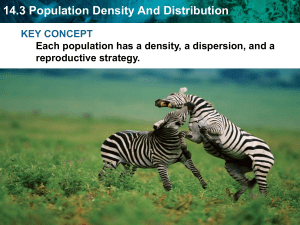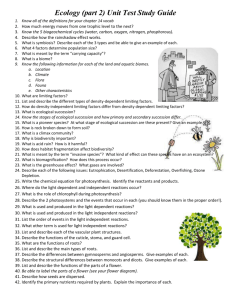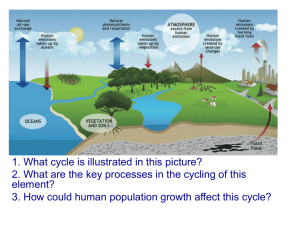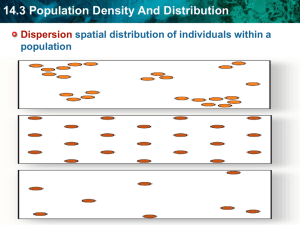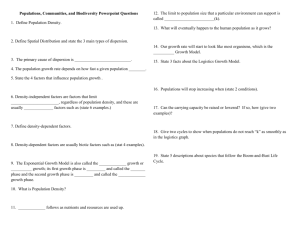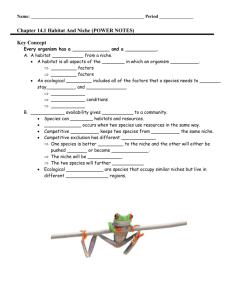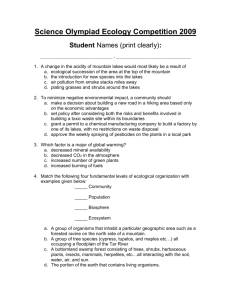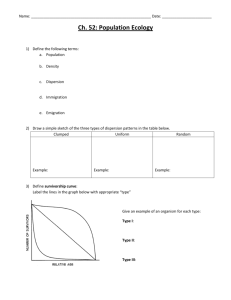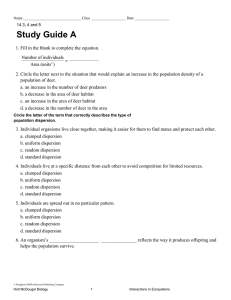File
advertisement
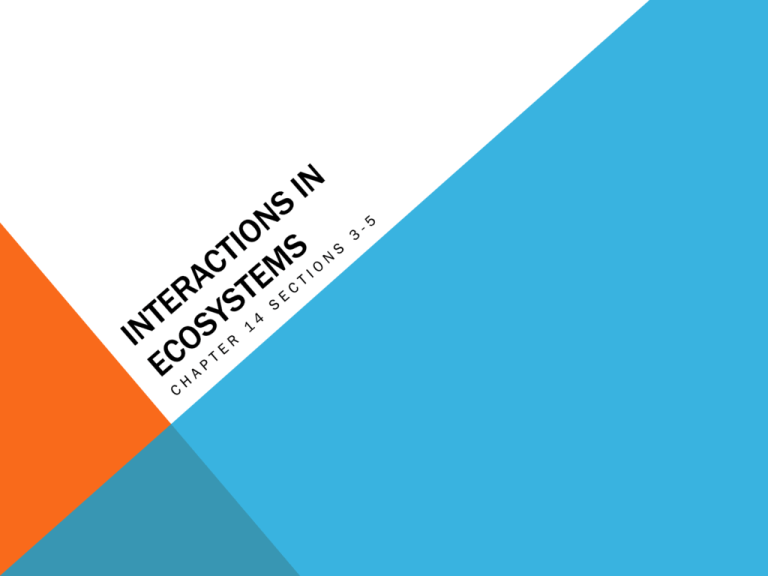
POPULATION DENSITY AND DISTRIBUTION Which has a higher density: a 40 car parking lot with 40 cars parked in it or a 1000 car parking lot with 40 cars parked in it? • By collecting data about a population in a particular area, scientists can calculate the density of a population. • Population Density is a measurement of the number of individuals living in a defined space. • Calculating this can tell us a lot about a species. • It can tell us if a change is environmental or if the changes are a part of the life history of a species. • The formula for this is: # of individuals/ area (units^2) = population density POPULATION DENSITY AND DISTRIBUTION So let’s practice this: 200 deer in an area that measures 10 square kilometers. • 200 deer would be the # of individuals and 10 square kilometers is our area. • 200 deer/ 10 square km = 20 deer per square kilometer POPULATION DENSITY AND DISTRIBUTION • We can learn other things by looking at population density like how individuals of the same species interact and how different species interact with one another. • Population dispersion is the way in which individuals of a population are spread in an area or volume. • We have 3 different kinds of dispersion: • Clumped dispersion • Uniform dispersion • Random dispersion POPULATION DENSITY AND DISTRIBUTION Clumped Dispersion : individuals may live close together in groups in order to facilitate mating, gain protection, or access food resources. POPULATION DENSITY AND DISTRIBUTION Uniform dispersion: territoriality and intraspecies competition for limited resources lead to individuals living at specific distances from one another. POPULATION DENSITY AND DISTRIBUTION Random dispersion: Individuals are spread randomly within an area or volume. POPULATION DENSITY AND DISTRIBUTION Survivorship curves illustrate how offspring survival from birth to death fits in with the survival strategies of a particular species. Survivorship curve: a generalized diagram showing the number of surviving members over time from a measured set of births. They give information about the life history of a species. Let’s look at the following: 100 coyotes are born. After one year 10 die. The next year 4 more die. In the third year 3 more die. The number that survives from year to year decreases, but there are plenty that will live a full life. This is an example of what we look for in a survivorship curve. POPULATION DENSITY AND DISTRIBUTION Type 1: represents a life history that is common among large mammals. Low levels of infant mortality and a population that will generally survive until old age. The most common characteristic for individuals in this group is parental care for their young. Type 2: Organisms like birds, small mammals, and some reptile show a survivorship that is pretty equal in all stages of life. Type 3: Organisms have very high birth rates and a very high infant mortality rate. These are normally invertebrates, fish, amphibians, and plants. POPULATION DENSITY AND DISTRIBUTION POPULATION GROWTH PATTERNS There are 4 things that determine a population’s size: Immigration-the movement of individuals into a population from another population Births- increase the number of individuals in a population Emigration- the movement of individuals out of a population and into another population Deaths- the size of a population decreases when individuals die POPULATION GROWTH PATTERNS Population growth is a function of the environment. Rate of growth is directly determined by the amount of resources available. 2 types of population growth: Exponential growth happens when a population size increases dramatically over a period of time. This is normally when resources are abundant. Logistic growth happens when a population begins with a period of slow growth followed by a brief period of exponential growth before leveling off at a stable size. In the beginning there are plenty of resources. After a while resources start to become scarce, as the resources become limited the population levels off. POPULATION GROWTH PATTERNS POPULATION GROWTH PATTERNS Our environments determine how many individuals can be supported based on natural cycles and species diversity. Carrying capacity of an environment is the maximum number of individuals of a particular species that the environment can normally and consistently support. The carrying capacity can change though when the environment changes. This will in turn change the population size. If the carrying capacity all of a sudden drops then the population will crash. Population crash is a dramatic decline in the size of a population over a short period of time. Example in the book: Reindeer on St. Matthew Island. POPULATION GROWTH PATTERNS Limiting factor: the factor that has the greatest effect in keeping down the size of a population. We have 2 types of limiting factors: density dependent and density independent Density-dependent limiting factors are limiting factors that are affected by the number of individuals in a given area. -Competition: members of a population are competing for resources like food and shelter. -Predation: populations of predators can be limited by the amount of prey, and the population of prey can be limited by being caught for food. -Parasitism and disease: spread more quickly through dense populations. POPULATION GROWTH PATTERNS POPULATION GROWTH PATTERNS Density-independent limiting factors are the aspects of the environment that limit a population’s growth regardless of the density of the population. -Unusual weather: can affect the size of a population regardless of its density. Example: Polar Vortex -Natural disasters: Tsunami’s, hurricanes, and tornados can wipe out population regardless of density. -Human activity: humans threaten habitats and the organisms that live in them. ECOLOGICAL SUCCESSION After an ecosystem gets wiped out because of some major catastrophe and begins to regrow , the space re-forms itself through succession. Succession is the sequence of biotic changes that regenerate a damaged community or create a community in a previously uninhabited area. This is the same process that created the Hawaiian Islands. ECOLOGICAL SUCCESSION Primary succession is the establishment and development of an ecosystem in an area that was previously uninhabited. The first organisms that live in an area that was uninhabited are called pioneer species. Examples are lichen and moss that can break down rock into smaller pieces. 1. Bare rock from lava cooling or an exposed glacier will start to break down from wind, rain, and ice. 2. Lichen and moss spores are blown in by wind. They break down rock even further. When they die the remains mix with the rocks to create soil. 3. Overtime seeds are blown in by wind or brought by birds . Small flowers and shrubs start to grow. These provide habitats for small animals. 4. As the soil gets thicker small trees take root, and different animals move into the area. 5. Different tree species take root in the shade and eventually replace the original trees, which need direct sunlight to grow. ECOLOGICAL SUCCESSION ECOLOGICAL SUCCESSION Secondary succession is the reestablishment of a damaged ecosystem in an area where the soil was left intact. Plants and other organisms that remain start the process of regrowth. Secondary succession has no end. Dynamic processes of succession change ecosystems all of the time.
